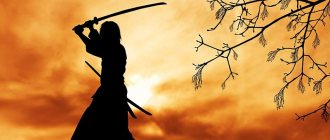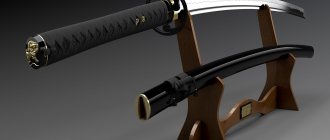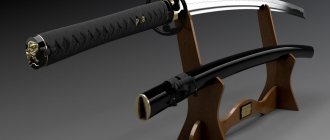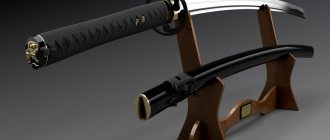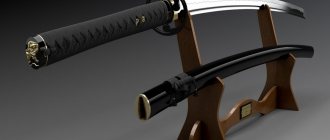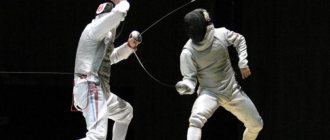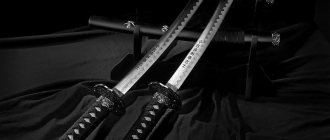Of course, the Japanese katana sword is not only the most famous weapon of Japan, but also its symbol known throughout the world. Let's take a closer look at what a katana sword is.
A katana is a long, curved two-handed sword. It has a long handle suitable for a two-handed grip, which makes it convenient for delivering cutting blows. The blade of the sword is slightly curved outward, which, in combination with the pointed, slightly curved end, allows this sword to be used for piercing blows. The blade of a katana has a length of 60 cm, and the weight of this Japanese weapon varies from 750 grams to 1.5 kilograms.
Making a katana
Making a katana is a very labor-intensive process that can take several months. We can roughly divide the making of a sword into several stages.
The most important role in the manufacture of a blade is played by the quality of the steel used by the blacksmith. Traditionally, Japanese craftsmen use refined steel (purified of harmful impurities - phosphorus, sulfur and slag). The main grade of steel used to make katanas (and other Japanese swords and daggers) is called tamahagane (Japanese for “diamond steel”). This steel is a unique Japanese invention and has been used since ancient times. This steel is produced in Japanese smelting furnaces - tatara, the temperature in such furnaces can reach 1500 ° C.
The first stage can be called steel preparation. Tamahagane ingots are coated with a clay solution (some blacksmiths also add ash at this stage). During the melting process, slag is released from the metal, which is absorbed by clay and ash.
The next stage of manufacturing is forging. The master heats the parts of the resulting steel to connect them. Next, the blacksmith begins to flatten the resulting block of steel with a hammer, folding it, thereby doubling the layers of steel. This operation can be repeated up to 20 times if necessary. In this way, the master achieves uniform distribution of carbon throughout the workpiece, which ensures incredible hardness of the future sword.
After this, the master needs to add softer steel, this is done so that the katana can withstand heavy force loads and not break. During the forging process, which can last from several days to a week, the block is stretched in length, and the gunsmith, by arranging layers of steel with varying degrees of hardness, creates the structure and preliminary appearance of the blade.
Next comes the blade hardening stage. Before hardening, the workpiece is again coated with a clay solution; this is necessary to prevent overheating of the workpiece and its oxidation. When quenching, the blade is heated to a high temperature and cooled instantly (usually using a bath of water), resulting in an incredibly hard and durable cutting edge. The katana blade consists of several parts - a hard cutting edge (yakiba) and a softer and more flexible back part (hiraji). During the hardening process, a hamon (the boundary between hard and softer steel) is formed between the yakiba and the hiraji.
After hardening is completed, a long process of sharpening, polishing and giving the final shape of the blade follows. Polishing is carried out by a separate master - togishi. Polishing the blade is done with stones of different grain sizes (an example is modern sandpaper with different grain sizes). A master can spend about five days of work on one sword. This work is very responsible, since the togishi must completely preserve the shape that the blacksmith gave the blade. Togishi also eliminates minor shortcomings in the work of a blacksmith. Modern craftsmen sometimes apply engravings to the handle and unhardened areas of the blade. Most often, the subjects for engraving are scenes from Buddhist epics.
After the blade is polished, the craftsman begins to create the handle and sheath of the katana. The sheath is called "saya" and the handle is called "tsuka". It is worth noting that all katanas are equipped with a sheath. Sayas are made of wood and are traditionally varnished. There are also non-varnished saya, the so-called “sarasaya” (white scabbard). The handle is traditionally covered with stingray skin or wrapped with silk laces. When the sheath and hilt are ready, the creation of the katana is complete. Modern katanas are made not only by hand, but also in factories, which, of course, has greatly simplified production and reduced the time it takes to make a sword. But still, the quality of steel remains an important and constant attribute.
What type of steel is best for a sword?
This is a fairly common question among beginners, the “best type” depends on the type of sword and what it is going to be used for.
It should be mentioned that there are a number of more important factors than the steel from which the sword is made (for example, the quality of the forging is more important than the type of steel the sword is made from - a sword made from a well-tempered piece of the cheapest unalloyed carbon steel is much better than a poorly tempered sword from steel L6.
But let's not complicate things!
So instead, let's ask "what types of steel are primarily used for forging swords - and what are their strengths and weaknesses" (when they're properly tempered, of course!)?
In the past, almost every sword was made of stainless steel. Now it is used only for cheap decorative swords - and for good reason!
Stainless steel swords (or any swords over 12″ in length) are considered too fragile for use and break very easily (as demonstrated in the infamous home shopping video below.
How to explain this from a technical point of view - stainless steel “does not rust” due to the fact that it contains a high percentage of chromium (more than 11%), and when the blade reaches a length of 12″ (sword), the bond between the chromium and steel weakens. So the place for stainless steel swords is on the wall.
Note: There are exceptions to this rule. Stainless steel swords can be used to practice non-contact forms.
unalloyed carbon steel
For a good sword (naturally, properly tempered), unalloyed carbon steel is best suited! But what does it mean?
When carbon steel is used for forging swords, it is designated by several numbers: the first two are 10, then there are numbers from 1 to 99 (each number indicates the content of 0.1% carbon in the steel.
For example, AISI 1045 steel contains 0.45% carbon, 1060 - 0.60%, etc.
Steels with a carbon content from 0.05 to 0.15% are considered low carbon steel, from 0.16 to 0.29 - medium steel. Neither one nor the other is suitable for swords, because steel with a carbon content of less than 0.40% cannot be properly hardened.
Most often, 3 types of carbon steel are used for forging swords: 1045, 1060 and 1095. Experts say that the ideal carbon content in steel suitable for a good and durable sword is from 0.5 to 0.7%, but 1045 steel, the most inexpensive, is also used.
Swords of this type became easy and inexpensive to make (both by hand forging and by pressing and on a machine). This steel can be hardened and requires minimal steel input.
When a sword of this kind of steel is well tempered, it is quite strong. And if you find an inexpensive sword that is labeled as "made from superior carbon steel," it is most likely 1045 steel and a machine-made sword.
Swords made from this steel are the perfect balance between strength and flexibility. They are also known for their durability. COLD STEEL swords are made of 1060 steel.
1060 swords have become very popular despite the fact that they are more difficult to forge.
An example of how durable swords made from 1060 steel are.
This steel is very hard, and if 1095 steel swords are not properly hardened, problems may arise when coming into contact with an even harder surface (such as when hitting a wooden stand).
So, steel with a high carbon content allows you to create especially sharp swords. But in this case, sharpness may cost the sword its strength.
Of course, this does not mean that swords made from 1095 steel are fragile! But there are certain advantages in strength for swords made from low-carbon steel.
1095 steel swords have a reputation for being "relatively" brittle, and the key word here is relatively. It all depends on what you need the sword for.
There are two types of spring steel we need - 5160 and 9260. Just like carbon steel, they contain 0.60% carbon (the perfect balance between strength and flexibility). When such steel is properly hardened, after a certain impact (for example, bending) it can return to its original shape.
It contains 7% chromium - not enough to make stainless steel (where a minimum of 13% is needed). Forged from such steel, it turns out to be very durable.
5160 steel was also used by the famous Nepalese Khurki. He created an incredibly sharp and durable sword, with which he cut off the head of a buffalo with one blow.
Again, it all depends on the hardening. A poorly tempered sword made from excellent quality steel may be useless.
In the video, the sword returns to its original shape after being bent 90 degrees!
Swords made from 9260 steel are almost twice as strong as swords made from 5160 steel (as efunda.com writes)
However, such swords can also break.
VIDEO: 9260 Sword Breaking
The video shows the sword breaking when hit poorly on thick bone (thicker than any human bone).
Moral: Any sword can break.
Recently, this steel has been quite popular - it makes strong, sharp swords. There are several types of this steel on the market. We'll talk about two of them: T10 and L6 Bainite
Tool steel T10
This tungsten alloy steel contains a high percentage of carbon (1%). This steel is commonly referred to as “high-speed.”
T10 is a very hard steel (HRC60) and swords, properly tempered, are very durable. Thanks to tungsten, T10 swords are more scratch resistant than other swords with the same carbon content. They are also comparatively heavier.
VIDEO: Destructive Testing of a T10 Tool Steel Sword
The video shows that T10 swords are very durable.
This is also a tool steel (used to make saws for cutting plaster casts) where L is a low-alloy alloy.
When properly tempered, such swords are considered the strongest. L6 swords gained this reputation thanks to the work of Howard Clark of the Bugei Trading company, who produced handcrafted L6 swords in the late 90s.
Such a sword is difficult to temper (due to the hardness of the steel), and it also needs to be constantly maintained in good condition, preventing it from rusting. Swords from L6 are the most expensive (from $1000 US)
Many people have a question about Damascus steel and many consider it to be the best for swords.
But even knowing this, many people have the impression that such steel is stronger than others, and the blades of swords made from such steel are sharper.
As for Japanese swords, historically this technology was applied to Japanese iron ore (not of very good quality) to improve its properties. Given the quality of ore today, such measures are not necessary.
Source
Katana care
They care for the katana using special tools. All actions are performed in strict sequence. First, nicks or deep scratches are removed using polishing stones. Then, with crumpled rice paper (to prevent scratches from large particles), the sword blade is cleaned of old oil. If the katana is very dirty, then lime is added to the rice paper, which removes dirt well and does not scratch the blade. Then, using a new sheet of rice paper, apply a small amount of oil (usually clove oil). A thin layer of oil will protect the blade from rust and dirt.
